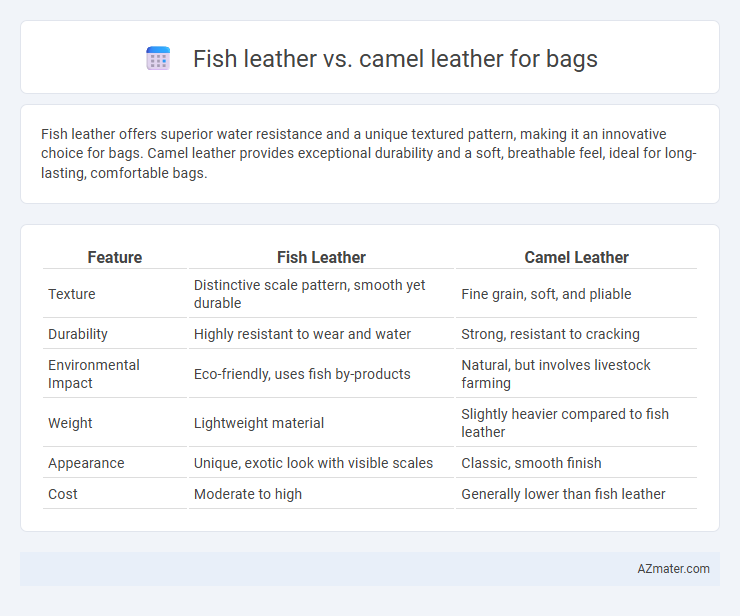Fish leather offers superior water resistance and a unique textured pattern, making it an innovative choice for bags. Camel leather provides exceptional durability and a soft, breathable feel, ideal for long-lasting, comfortable bags.
Table of Comparison
| Feature | Fish Leather | Camel Leather |
|---|---|---|
| Texture | Distinctive scale pattern, smooth yet durable | Fine grain, soft, and pliable |
| Durability | Highly resistant to wear and water | Strong, resistant to cracking |
| Environmental Impact | Eco-friendly, uses fish by-products | Natural, but involves livestock farming |
| Weight | Lightweight material | Slightly heavier compared to fish leather |
| Appearance | Unique, exotic look with visible scales | Classic, smooth finish |
| Cost | Moderate to high | Generally lower than fish leather |
Introduction: Fish Leather vs Camel Leather for Bags
Fish leather offers a unique texture and exceptional durability, making it a sustainable alternative to traditional camel leather in bags. Camel leather boasts natural toughness and a smooth grain pattern, favored for its classic elegance and robustness in luxury accessories. Both materials provide distinctive aesthetic appeal and environmental benefits, appealing to eco-conscious consumers seeking innovative leather options.
Sustainability and Environmental Impact
Fish leather, derived from by-products of the fishing industry, presents a sustainable alternative to camel leather by reducing waste and utilizing fast-renewing aquatic resources. Camel leather, while durable and naturally resistant to wear, has a higher environmental impact due to the methane emissions and land use associated with camel farming. Fish leather production typically uses fewer chemicals and less water in tanning processes, making it a more environmentally friendly option for eco-conscious bag manufacturing.
Sourcing and Availability
Fish leather, primarily sourced from species like salmon, cod, and perch, is a sustainable byproduct of the fishing industry with limited but growing availability due to increasing demand in fashion. Camel leather, derived from camel hides mainly in regions such as the Middle East, North Africa, and parts of Asia, offers a more abundant and traditional source with established supply chains. The sourcing of fish leather depends on sustainable fisheries and waste utilization, whereas camel leather relies on livestock farming and regional availability, affecting both materials' accessibility for bag production.
Durability and Strength Comparison
Fish leather, known for its exceptional durability and tensile strength, often surpasses camel leather in terms of resilience due to its unique scale structure and dense fiber composition. Camel leather, while naturally thick and tough, tends to be more flexible but may exhibit less resistance to abrasion and wear compared to fish leather. Both materials offer high durability, but fish leather generally provides greater longevity and strength for bags exposed to frequent use and harsh conditions.
Texture and Appearance Differences
Fish leather features a distinctive scaled texture with natural patterns that create a unique, eye-catching appearance, often smoother and more flexible than traditional leathers. Camel leather typically presents a more uniform, grainy texture with a matte finish and subtle natural markings, offering a rugged yet refined look. The striking contrast between fish leather's glossy, patterned surface and camel leather's muted, consistent texture makes each ideal for different aesthetic preferences in bag design.
Craftsmanship and Workability
Fish leather, known for its fine grain and flexibility, allows craftsmen to create intricate designs and detailed embossing, offering a unique texture that enhances bag aesthetics. Camel leather, thicker and tougher, provides durability and a rugged appeal, requiring skilled techniques to soften and shape it without compromising its strength. Both materials demand specialized knowledge, but fish leather's lightweight nature often results in more delicate and refined craftsmanship compared to the robust, long-lasting workability of camel leather.
Comfort and Weight in Bag Design
Fish leather offers a lightweight and flexible option for bag design, enhancing comfort without compromising durability. Camel leather tends to be thicker and heavier, providing more structure but potentially increasing the overall weight of the bag. Designers aiming for ergonomic and lightweight bags often prefer fish leather due to its superior softness and reduced bulk.
Cost and Market Trends
Fish leather for bags offers a unique, eco-friendly alternative with moderate production costs driven by sustainable sourcing and limited supply chains, often resulting in higher price points compared to traditional leathers. Camel leather, favored for its durability and distinctive grain, remains competitively priced due to established market demand and more accessible raw materials. Market trends reveal a growing consumer interest in exotic and sustainable leathers, increasing the demand and value of fish leather while camel leather maintains steady popularity in luxury and artisanal bag segments.
Maintenance and Longevity
Fish leather offers high durability and is naturally resistant to water and bacteria, requiring minimal maintenance such as gentle cleaning and occasional conditioning to preserve its unique texture. Camel leather, known for its softness and flexibility, demands regular conditioning and protection from moisture to prevent cracking and extend its lifespan. Both materials provide long-lasting quality, but fish leather generally outperforms in longevity due to its robust natural properties and low maintenance needs.
Best Uses and Consumer Preferences
Fish leather, known for its unique texture and water resistance, excels in crafting eco-friendly and stylish bags favored by consumers seeking sustainable luxury. Camel leather offers durability and a smooth finish, making it popular for high-quality, long-lasting bags preferred by traditional leather enthusiasts. Both materials cater to distinct consumer preferences, with fish leather attracting trend-conscious buyers and camel leather appealing to those valuing classic strength and elegance.

Infographic: Fish leather vs Camel leather for Bag
 azmater.com
azmater.com